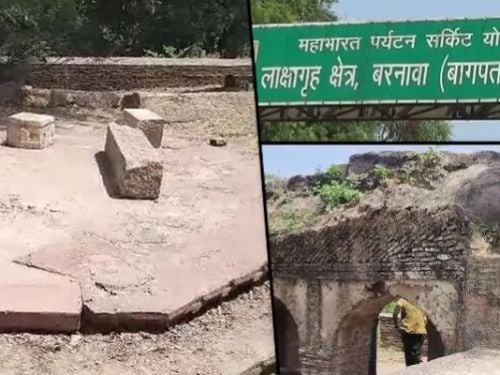
Ending a 53-year-long legal battle, the Additional District Judge (ADJ) Court in Baghpat on 5th February (Monday), handed over the ownership rights of over 100 bighas of land related to Mahabharata era Lakshagriha to the Hindu side. The Civil Judge Shivam Dwivedi rejected the suit of the Muslim side which claimed the presence of the tomb of Badruddin and a graveyard at the site to dispute the nature of the site and/or stake claim over it.
Notably, the said parcel of land falls in Baghpat, Uttar Pradesh and spans over 108 bighas. Additionally, a tunnel is also present here which is said to be from the Pandava period. It is claimed that the Pandavas escaped from Lakshagriha through this tunnel.
The case involving the Lakshagriha had been ongoing in the courts between the Hindu and Muslim sides since 1970 which was first filed in a Meerut court. In the year 1970, this case was going on before the Civil Judge Junior Division I in the then Meerut (Baghpat was not a district then, Baghpat was made a district in 1997) District and Sessions Court.
Its hearing was going on for 53 years and was being heard in Baghpat District and Sessions Court. During the court trial, more than 10 witnesses from the Hindu side had testified in this case and the opinions of historians were also taken in this case.
Historian Amit Rai said that during the excavation of this land, evidence dating back thousands of years was found. All this evidence is related to Hindu civilisation, he added.
Muslim side had claimed the presence of a tomb and graveyard at the site
In their appeal, the Muslim side had declared the defendant Krishnadutt Maharaj an outsider. The Muslim petitioners had claimed that the tomb of Sheikh Badruddin is located on the mound where Hindus believe Lakshgriha is located adding that it was removed. However, the court rejected the claim of the Muslim side and handed over the entire land parcel to the Hindus.
In their petitions, the Muslim sides had also claimed the presence of a graveyard of Muslims around the alleged tomb of Badruddin which according to them belonged to the Muslim Waqf Board.
The Muslim side further claimed that Krishnadutt Maharaj wanted to destroy the Muslim graveyard and intended to make it a pilgrimage site for Hindus.
Both Krishnadutt Maharaj, who presented evidence on behalf of the Hindu side, and Muqeem Khan, who filed the case on behalf of the Muslim side, had passed away and others have been advocating in this case.
The Hindu side’s lawyer Ranveer Singh argued that the Muslim side was trying to capture 100 bighas of land by claiming it as a graveyard and a tomb. For this, he had presented all the evidence before the court. He had told the court that the history of Lakshagriha dates back to the Mahabharata period. Traces of Sanskrit school and Mahabharata period are also present on this mound.
Earlier, the Lakshagriha mound had been identified in Barnawa of Baghpat. During the excavation in 1953, items of archaeological importance about 4500 years old were also found here. Now this place identified as Lakshagriha built by Duryodhana was in the possession of the Archaeological Survey of India (ASI).
However, in the year 1970, the Uttar Pradesh Waqf Board staked its claim on this place. On behalf of the Waqf Board, Muqeem Khan described the Lakshgriha mound as the tomb of Badruddin Shah and the surrounding graveyard and filed a lawsuit claiming ownership over it.
At the same time, it was being said from the defence side that this is the Lakshagriha of Pandavas. There is a tunnel from the Mahabharata period, mythological walls and an ancient mound present here. The Archeology Department has also recovered important antiquities from here.
It is said that this mound is the same Lakshagriha, where an attempt was made to burn the Pandavas. Kauravas had built this Lakshagriha and set it on fire to kill the Pandavas, but the Pandavas came out of a tunnel. This tunnel still exists in Barnawa. Here, the mound has been excavated by ASI Delhi in 2018 by digging a trench, in which pottery and evidence of the Rajput period has also been found.
Source: OpIndia

 Shiv Sena leader demands action against Bigg Boss OTT 3 over ‘obscene’ content
Shiv Sena leader demands action against Bigg Boss OTT 3 over ‘obscene’ content Conduct a thorough enquiry of individuals coming to Vishalgad Fort from Hyderabad involved in distributing money to the local Muslims : Ramesh Shinde, HJS
Conduct a thorough enquiry of individuals coming to Vishalgad Fort from Hyderabad involved in distributing money to the local Muslims : Ramesh Shinde, HJS Kalki 2898 AD: Legal notice served to team for allegedly hurting Hindu sentiments
Kalki 2898 AD: Legal notice served to team for allegedly hurting Hindu sentiments NGO worker distributes books on Jesus to the school students in Vidisha (MP)
NGO worker distributes books on Jesus to the school students in Vidisha (MP) Kanwar Yatra: SC stays U.P., Uttarakhand directives to display names of food stall owners and staff en route
Kanwar Yatra: SC stays U.P., Uttarakhand directives to display names of food stall owners and staff en route The Bombay HC orders stay on removal of encroachments at Vishalgad (Kolhapur)
The Bombay HC orders stay on removal of encroachments at Vishalgad (Kolhapur)